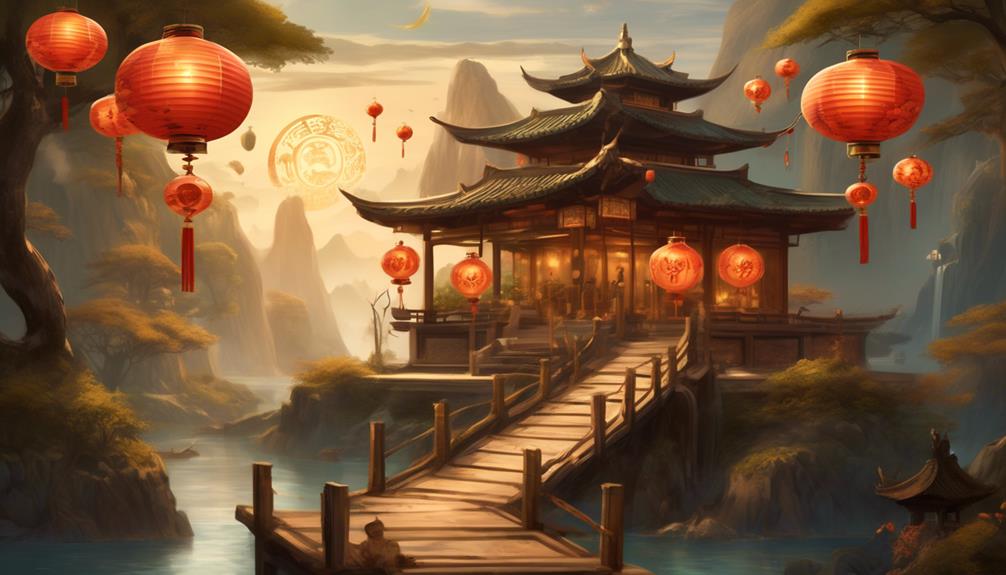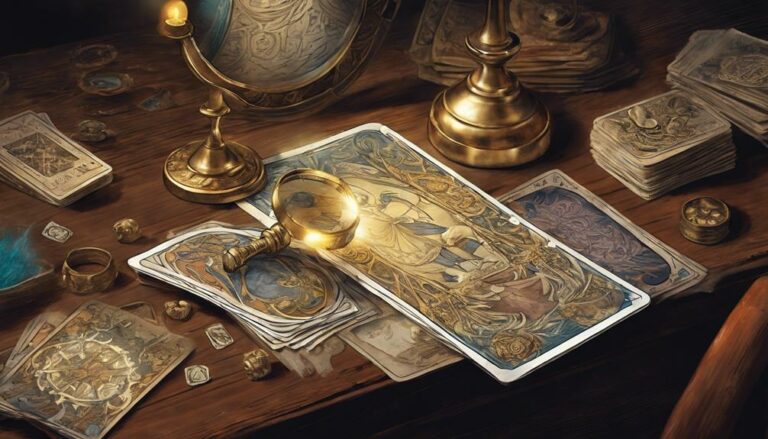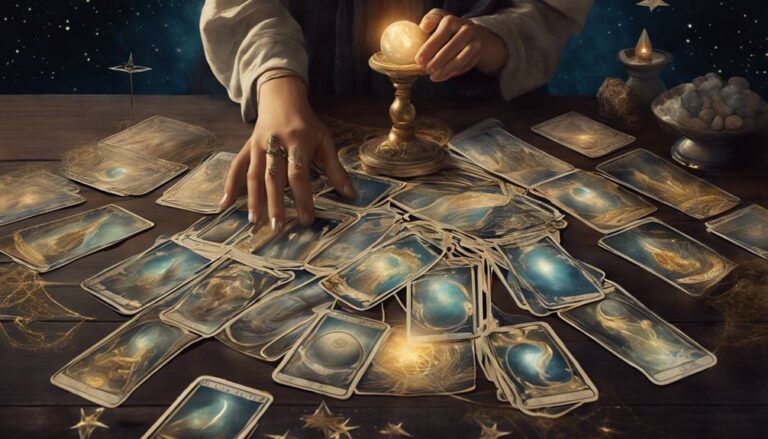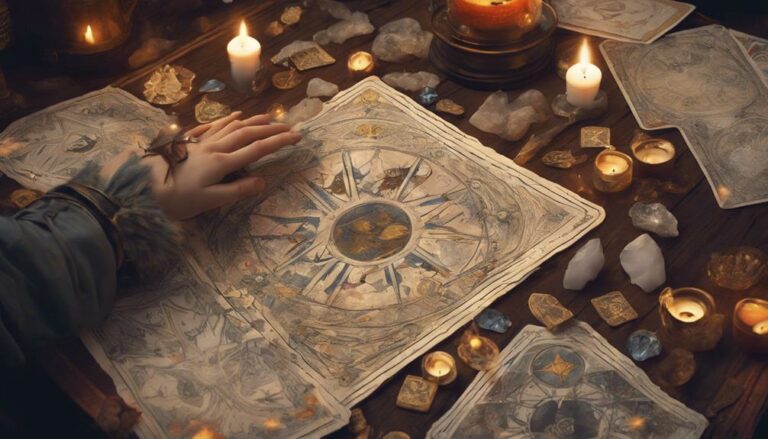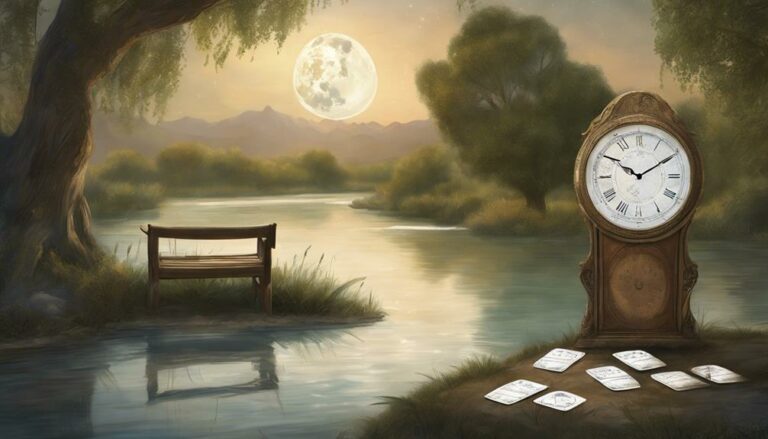As I wandered through a bustling market in Hong Kong, a set of tarot cards, unlike any I’d seen before, caught my eye. Each card was a window into a world where Asian philosophies were not just ideas but living, breathing entities.
Table of Contents
This experience introduced me to the fascinating realm of tarot cards inspired by Asian philosophies, a blend of ancient wisdom and modern mysticism that offers a unique twist on traditional tarot interpretations. These decks, rich with symbols from Chinese mythology, Feng Shui principles, and Zen philosophies, invite us on a journey that goes beyond mere fortune telling.
They encourage a deeper understanding of ourselves and the world around us through a cultural lens that is often overlooked in mainstream tarot practices. As we explore the intricate connections between these cards and the philosophies that shape them, we uncover layers of meaning that resonate with our own life experiences and spiritual quests.
The question then becomes, how can these ancient philosophies, encapsulated in a deck of tarot cards, influence our modern lives and decision-making processes?
Key Takeaways
- Tarot cards inspired by Eastern philosophies, such as Taoism, Zen, I Ching, Buddhism, Confucianism, Hinduism, Feng Shui, and Shintoism.
- The fusion of Eastern philosophies with tarot reading reflects the interconnectedness and fundamental nature of the universe.
- Incorporating Eastern symbolism and concepts enriches the interpretation of tarot cards, adding layers of meaning and complexity.
- Tarot cards inspired by Asian philosophies offer philosophical insights, personal growth, clarity, insight, and peace to readings, guiding individuals on their spiritual journey.
The Tao of Tarot
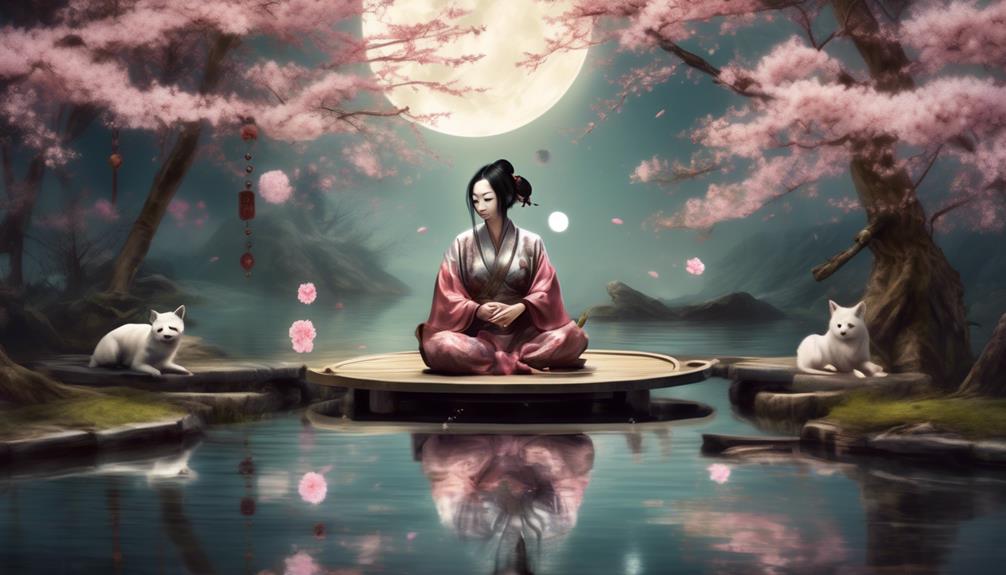
In exploring the Tao of Tarot, we uncover the harmonious blend of ancient Eastern philosophies with the mystical art of tarot reading. This synthesis enriches the card designs and infuses them with deep symbolic meanings, creating a unique pathway for seekers like myself to access wisdom.
The Tao, which signifies the fundamental nature of the universe, is reflected in the intricate imagery and motifs found in these cards. It’s fascinating how each element, color, and symbol on the cards draws from Taoist concepts, guiding us toward understanding the balance and flow of life’s energies.
The card designs aren’t merely aesthetic; they’re gateways to the profound. They serve as mirrors, reflecting the interconnectedness of all things, a principle at the heart of Taoist philosophy. As I delve deeper into the symbolic meanings, I find that they offer not just predictions but also philosophical insights, encouraging introspection and personal growth.
This blend of art and philosophy in the Tao of Tarot has opened my eyes to new ways of seeing the world and my place within it. It’s a journey of discovery, where ancient wisdom illuminates the path ahead.
Zen and Card Interpretations
Building on the rich tapestry of the Tao of Tarot, I now explore how Zen principles enhance our understanding of card interpretations through their emphasis on simplicity and presence.
Zen philosophy, with its focus on the present moment and the interconnectedness of all things, offers a unique lens through which to view tarot readings. It encourages us to approach each card and its symbols with an open heart and mind, free from preconceived notions or attachments to specific outcomes.
This approach emphasizes mindfulness in card interpretations, urging us to be fully present with the imagery, messages, and feelings that arise during a reading. By connecting with the present moment, we align more closely with the true essence of the cards, enabling a deeper understanding and more insightful readings.
Zen teaches us that every card, like every moment, is complete and perfect in itself, containing the wisdom we need if only we’re attentive and receptive.
Incorporating Zen principles into tarot readings brings clarity, insight, and a profound sense of peace to both the reader and the querent. It transforms the experience into a meditative practice, enriching our spiritual journey and deepening our connection to the universal wisdom the tarot embodies.
I Ching Influences
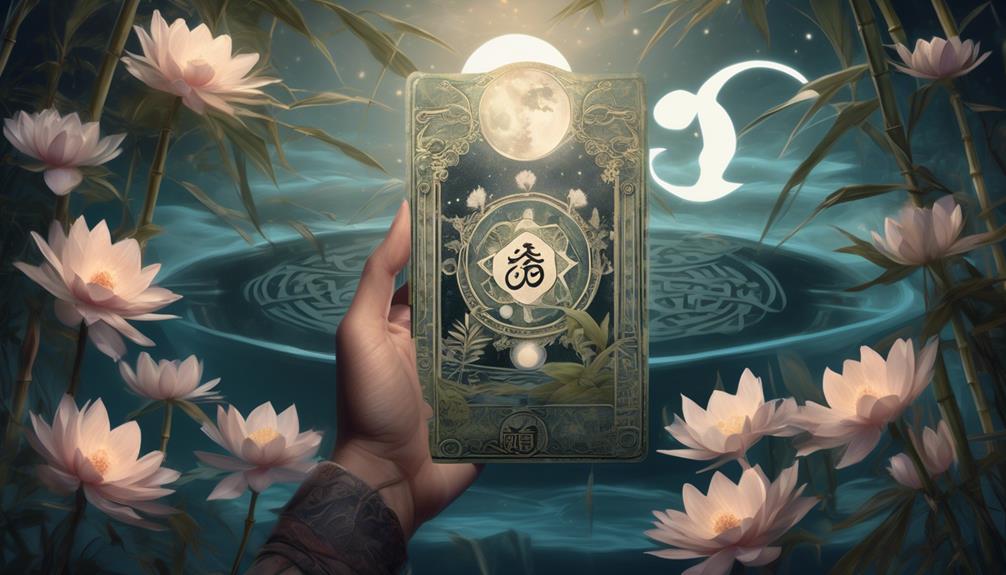
Exploring the I Ching influences in the Chinese Tarot Deck reveals a rich tapestry of symbolism and philosophy. Through the integration of I Ching symbolism, the deck not only captures the essence of ancient Chinese wisdom but also invites users to explore philosophical themes within their readings.
Additionally, the adaptation of divinatory practices from the I Ching enhances the interpretative depth of both the Major and Minor Arcana, offering a unique lens through which to view the cards.
I Ching Symbolism Integration
How do the ancient symbols of the I Ching enrich the narrative and depth of Asian-inspired Tarot cards? The integration of I Ching’s hexagram correspondences into Tarot offers a unique layer of meaning, blending the wisdom of both systems. This synergy not only adds complexity but also ensures a Yin Yang balance, reflecting the dual nature of existence.
| I Ching Symbol | Tarot Card Influence |
|---|---|
| Hexagram 1 (乾, Qián) | The Magician – Symbolizing creation and initiative |
| Hexagram 2 (坤, Kūn) | The High Priestess – Representing receptivity and mystery |
| Hexagram 64 (未济, Wèi Jì) | The Tower – Indicating transition and upheaval |
This table showcases how specific hexagrams directly influence the interpretation and energy of Tarot cards, enriching the reader’s experience with a profound resonance that bridges cultural wisdom.
Philosophical Themes Explored
Having examined the symbolic interplay between the I Ching and Tarot cards, I now turn our focus to the philosophical themes that these ancient Chinese influences unveil within the deck.
The Chinese Tarot Deck, masterfully designed by Jui Guoliang, is a rich tapestry of themes drawn from ancient Chinese literature, legend, philosophy, and culture. It intricately weaves the yin yang balance and Taoist teachings into tarot, offering a unique lens through which to view the universal experiences depicted in the Major and Minor Arcana.
Featuring inspirational figures such as Confucius and Kuan Yin, the deck isn’t just a tool for divination but a journey into the heart of Chinese philosophical thought, inviting us to explore the equilibrium and harmony inherent in life’s ebb and flow.
Divinatory Practices Adapted
I’ll delve into how I Ching’s profound influence reshapes traditional divinatory practices, introducing hexagrams and dynamic interpretation methods that enrich the art of tarot reading. The fusion of I Ching with tarot reflects a beautiful tapestry of cultural fusion in divination, where yin yang interpretations offer a balanced view of life’s complexities.
| Method | Influence |
|---|---|
| Coin Tossing | Adds spontaneity to readings |
| Yarrow Stalks | Connects deeply with tradition |
| Digital Apps | Modernizes ancient wisdom |
| Hexagrams | Introduces structured insights |
| Yin and Yang | Balances interpretations |
This blend not only respects the rich legacy of I Ching but also invites a fresh perspective in understanding tarot, making each reading a journey through wisdom old and new.
Buddhism in Tarot Imagery
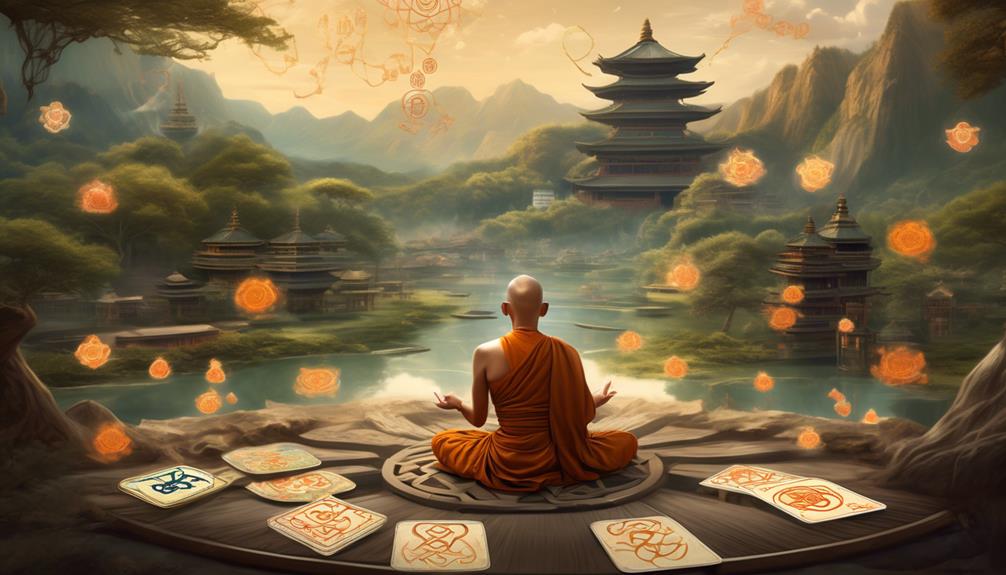
The fusion of Buddhist symbols and principles into tarot imagery enriches the spiritual journey of seekers by offering a unique lens through which to explore interconnectedness and enlightenment. Incorporating elements like the Wheel of Dharma and Bodhisattvas, these cards weave a rich tapestry of meditative symbolism and cultural fusion. They invite us into a realm where the cyclical nature of existence and the path to spiritual awakening are visually depicted, making profound Buddhist concepts accessible and engaging.
By featuring Buddhist deities and the idea of impermanence, karma, and interconnectedness, the tarot becomes more than just a tool for divination. It transforms into a guide for personal growth and understanding, rooted in centuries-old wisdom. The imagery, inspired by Buddhist art and temples, serves not only as a bridge between spiritual traditions but also as a reminder of the shared journey towards enlightenment.
This integration of Buddhist philosophy and tarot symbolism opens up new avenues for reflection on our own lives, emphasizing mindfulness, meditation, and the pursuit of spiritual enlightenment. It’s a beautiful example of how two rich traditions can come together to offer insights and guidance for our personal and spiritual development.
Confucian Principles in Readings
Drawing upon Confucian principles, tarot readings often illuminate the intricate dance between personal integrity and societal expectations, guiding seekers towards a harmonious existence. These readings delve into the realms of relationships, authority, and ethical decision making, reflecting the core values of social harmony, hierarchy, and respect for elders intrinsic to Confucianism. They encourage us to navigate moral and ethical dilemmas with virtue, always considering our role within the community or family structure.
Central to these readings is the concept of filial piety, highlighting the importance of family dynamics and responsibilities. This focus fosters a profound understanding of our familial relationships and our duties towards them, urging us to honor our parents and ancestors in our actions and decisions.
Moreover, tarot readings inspired by Confucian principles prompt introspection on balancing individual desires with societal expectations. They champion the cause of self-improvement and ethical conduct, guiding us to a deeper comprehension of our place within a broader social fabric. Through this lens, we’re not just seeking answers but striving for a higher standard of personal integrity and social responsibility, aligning our actions with the greater good.
Hinduism and Tarot Symbolism

How does Hinduism’s rich tapestry of deities and spiritual concepts weave into the symbolism of tarot cards, offering seekers a unique lens through which to explore their inner worlds and the universe’s mysteries? By integrating Hindu mythology and philosophy, tarot decks become more than just tools for divination; they become guides for spiritual reflection and growth.
- Karma and Tarot Readings: The concept of karma, the law of cause and effect, enriches tarot readings by reminding us that our actions and intentions set the stage for our future. It encourages a mindful approach to decision-making, highlighting the interconnectedness of our choices and their outcomes.
- Dharma in Tarot Interpretations: Dharma, or one’s righteous duty, offers a profound layer to tarot interpretations, guiding individuals toward understanding their life’s purpose and moral obligations. It’s about aligning one’s actions with cosmic law and personal virtues.
- Major Arcana Inspiration: Incorporating figures like Shiva and Kali into the major arcana brings forward themes of creation, destruction, and rebirth, reflecting the cyclical nature of life and the universe.
- Minor Arcana Representation: Through symbols like lotuses and chakras, the minor arcana connects everyday experiences to broader spiritual lessons, offering insights into personal growth and enlightenment.
This blend of Hinduism and tarot symbolism creates a deeply enriching practice, allowing for a more holistic exploration of one’s spiritual journey.
Feng Shui and Card Layouts
Incorporating Feng Shui into tarot card layouts offers a unique path to achieving harmony and balance within a reading. By aligning the spreads with elemental energies, we can tap into deeper, more nuanced insights.
The spatial arrangement of cards, guided by Feng Shui principles, enhances the reader’s connection to the universal energy flow. This connection offers a more profound understanding of the querent’s situation.
Harmony in Card Spreads
Harnessing the principles of Feng Shui, the strategic arrangement of tarot cards in a spread can significantly enhance the energy flow and balance, elevating the reading to a harmonious experience. By adopting strategies for balance and incorporating energy flow, we tap into an ancient wisdom that enriches the practice of tarot reading.
Here are four key principles to consider:
- Align cards to represent the five elements, fostering a balanced energy.
- Place cards intentionally to encourage positive flow and connectivity.
- Use shapes and layouts that mirror Feng Shui principles, promoting harmony.
- Consider the querent’s energy and align the spread accordingly, creating a personalized sense of equilibrium.
These practices not only enhance the reading but also bring a deeper sense of tranquility and insight.
Elemental Energies Alignment
Aligning elemental energies through Feng Shui principles in Tarot card layouts can significantly enhance the reading’s depth and the seeker’s connection to the natural world. By understanding the five elements – wood, fire, earth, metal, and water – and their influence on our lives, I can create a harmonious environment that amplifies the energy and intention behind each reading.
Incorporating nature into card layouts isn’t just about aesthetics; it’s a way to tap into the universe’s profound wisdom and balance. This approach allows me to interpret Tarot spreads with deeper insights, fostering a sacred space that promotes clarity, intuition, and spiritual growth.
The alignment of tarot and elemental energies becomes a powerful tool for navigating life’s challenges, guiding seekers towards a path of harmony and enlightenment.
Spatial Arrangement Insights
Building on the foundation of elemental energies, I’ll now explore how Feng Shui principles applied to Tarot card layouts can unlock profound spatial arrangement insights, enhancing the reading’s resonance and depth.
- Directional Alignment: Aligning cards with specific compass directions can tap into the flow of Qi, enhancing the reading’s clarity.
- Geometric Symbolism: Configurations like circles or squares offer unique interpretations, blending cultural insights with personal intuition.
- Centering Key Cards: Placing significant cards at the heart of the spread can mirror the importance of the central palace in Feng Shui, emphasizing balance.
- Cultural Interpretations: Integrating Asian philosophies enriches readings, offering a multifaceted perspective through the lens of cultural wisdom.
These approaches invite a deeper understanding and respect for both Tarot and Feng Shui’s rich traditions.
Shintoism’s Spiritual Connection
In the realm of Shintoism, the spiritual connection to nature plays a pivotal role in shaping its practices and beliefs. This relationship is deeply engrained, with Kami representations embodying various elements of nature, from mountains and rivers to wind and trees. These Kami aren’t just abstract concepts; they’re seen as living entities that interact with us, offering guidance and protection. It’s a perspective that fosters a profound respect for the natural world, encouraging us to live in harmony with it.
Ritual purification, or Misogi, is another crucial aspect, symbolizing the cleansing of the body and spirit from impurities. This practice reflects the importance of purity in Shintoism, aiming to maintain a balanced and positive relationship with the Kami. Engaging in Misogi, one can feel a deeper connection to the spiritual world, enhancing their understanding and appreciation of the Kami’s presence in everyday life.
Drawing from these principles, I’ve found a rich source of inspiration for my tarot designs. Each card, infused with the essence of Shintoism, invites reflection on our connection to the natural world and the spiritual entities that dwell within it. Through this project, I aim to bridge the gap between ancient wisdom and modern seekers of enlightenment.
Frequently Asked Questions
What Culture Did Tarot Cards Come From?
I’ve learned that tarot cards originated in 15th-century Europe, with their historical evolution deeply rooted in Italian playing card decks. This fascinating card origins journey reflects a rich tapestry of cultural and spiritual insights.
What Religion Is Associated With Tarot Cards?
I’ve learned that tarot cards aren’t tied to a single religion; they’re used in various occult practices for spiritual guidance. Their versatility allows them to transcend specific beliefs, offering insight to seekers from many backgrounds.
Are There Japanese Tarot Cards?
Yes, Japanese tarot cards exist and beautifully intertwine traditional Japanese mythology with unique artistic styles. They offer a reflective journey, blending familiar tarot themes with the rich narratives and aesthetics of Japan’s cultural heritage.
What Country Are Tarot Cards From?
Plunging into the depths of history, tarot cards’ roots trace back to Europe. Their journey, a tapestry of cultural exchange, reveals a rich historical evolution. Card origins, entwined with mysticism, began in the 15th century.
Conclusion
As I shuffled my new deck, inspired by the rich tapestry of Asian philosophies, it felt like the universe whispered ancient wisdom through the cards. It’s as if the teachings of Tao, Zen, and the I Ching were destined to guide me at this moment.
Each card, imbued with the essence of Buddhism, Confucianism, Hinduism, and more, seemed to bridge my soul to these profound traditions. It’s a beautiful coincidence, finding this connection just when my heart sought deeper understanding.
Truly, these cards are a gateway to spiritual enlightenment.

